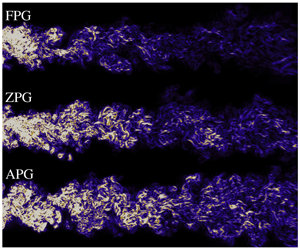Article contents
Compressible plane turbulent wakes under pressure gradients evolving in a constant area section
Published online by Cambridge University Press: 08 April 2020
Abstract

Development of statistically two-dimensional (2-D) turbulent wakes under pressure gradients is a common feature of many industrial and aerodynamic flows. The usual set-up is to generate a wake, and study its development through a passage with a variable area; if the downstream area decreases (increases) a favourable pressure gradient or FPG (adverse pressure gradient or APG) is imposed. In applications such as in turbomachinery, however, the wakes develop in a periodic constant area passage in the stator–rotor gap and with an imposed pressure gradient. To study these flows, here, we develop a canonical set-up for this new kind of wake evolution in FPG and APG of different strengths by placing a 2-D flat plate normal to the flow in a periodic constant area passage and a fixed inflow mass flux. Employing compressible direct numerical simulations, we impose pressure gradients through a ramped body force term to the momentum and total energy equations while the wake is allowed to develop spatially in a region of fixed width. The resultant mean velocity statistics, wake width, energy budgets and entropy generation rates are scrutinised to assess the effect of the pressure gradients, and where possible, the similarities and differences to the conventional case of variable area pressure gradients are discussed. The results show that the effect of a constant area pressure gradient on flow statistics is non-trivial, resulting from significant density changes. The pressure gradients also have an effect on the different energy budgets, which produces a gain for FPG and loss for APG in the mean kinetic energy. Consequently, the entropy generation rate diminishes and augments for the FPG and APG, respectively, compared to the zero pressure gradient. Finally, the effect of different passage heights ( $H$) relative to the wake half-width (
$H$) relative to the wake half-width ( $\unicode[STIX]{x1D6FF}$) is studied using large eddy simulations. We find that wake width and hence the spreading, depends primarily on the wake–wake interaction for small
$\unicode[STIX]{x1D6FF}$) is studied using large eddy simulations. We find that wake width and hence the spreading, depends primarily on the wake–wake interaction for small  $H$ and pressure gradients for larger
$H$ and pressure gradients for larger  $H$, and this has implications for the design of turbomachinery.
$H$, and this has implications for the design of turbomachinery.
- Type
- JFM Papers
- Information
- Copyright
- © The Author(s), 2020. Published by Cambridge University Press
References
- 4
- Cited by


